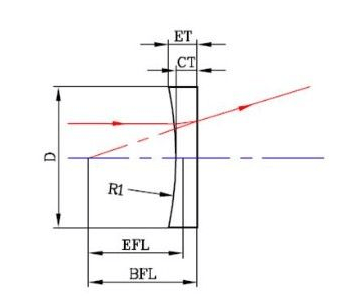Plano Concave Lens Specification
Material
The material substrate determines such features as hardness, scratch resistance, and transmission range. We offer plano concave lenses in Schott, Ohara, and CDGM optical glass as well as Corning 7980 fused silica, UV fused silica, infrared fused silica, calcium fluoride (CaF2), Barium fluoride (BaF2), Germanium, Zinc Selenide, and Zinc Sulfide.

Diameter Tolerance
The diameter tolerance of a plano concave lens describes the acceptable value of ranges for the diameter. It has no effect on the performance of the lens, but relates to how the lens is fitted into its mount or holder. Our factor standard is a diameter tolerance of +/-0.05mm, and our manufacturing limit is +/-0.01mm.
Thickness Tolerance
The center thickness of a lens describes the allowable variation in the material thickness. It is measured at the exact mechanical axis of a lens, directly between its outer edges. This specification does affect optimal performance because it is the lens thickness which helps to determine the optical path taken by light passing through the lens. Our factor standard for center thickness is +/-0.05mm, and our manufacturing limit is again +/-0.01mm.
Clear Aperture
The clear aperture is the diameter of the part of the lens which meets specifications. Manufacturing constraints mean that the outer rim of a lens can never be as clear as the crucial inner aperture, but our factory standard for clear aperture is greater than 95 percent of the central dimension.
Centration
The amount of decenter in a lens is defined as the physical displacement of the lenses mechanical axis (i.e., geometric axis) from its optical axis. The line that connects the centers of curvature for the surfaces is the optical axis. Our factory standard for centration is less than 3 arc minutes, and our manufacturing limit is 1 arc minute.
Surface Quality
Surface quality refers to the absence or presence of scratches, pits, and digs. In most applications these are only cosmetic defects, but for high powered laser applications high surface quality is important because they can increase energy absorption to a level that damages the optic. The surface quality is specified by a two part scratch dig number, and the lower the quality, the higher the number. 80-50 is generally considered standard quality, but our factory standard is 40-20 (after coating). We are also able to provide extremely high quality 10-5 plano concave lenses at a cost premium.
Surface Irregularity
Surface irregularity refers to how the shape of the surface deviates from that of the reference surface. Our factory standard for irregularity is for less than ¼ lambda deviation, and our manufacturing limit is for less than 1/10 lambda.